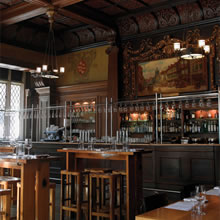Case Studies
Andaz Hotel, London
Turning on the style in a Victorian masterpiece.
The redbrick Victorian exterior of what was known for 123 years as the Great Eastern Hotel alongside London’s Liverpool Street Station was a prominent landmark on the eastern side of the city. Since the turn of the millennium, the hotel has undergone a period of change. The hotel had assumed an air of faded grandeur before its first major facelift. This was a £50 million refurbishment, under the guidance of co-owner Terence Conran and led to the hotel playing a prominent role in the renaissance of Old Street and the surrounding area.
Today the Great Eastern is no more. Now part of the Hyatt Hotel chain, it's known as the Andaz and a three-year refurbishment costing a total of £70 million has restored many of the original Victorian architectural features, and introduced a bold, contemporary aesthetic. The hotel includes 267 bedrooms, 12 private dining and event rooms, 4 restaurants, 4 bars and a gym.

The Andaz's architectural and historical credentials are impeccable, so the brief to work on the redesign of the project came with some responsibility. The hotel, which opened its doors in 1884, was designed by Sir Charles Barry and his son, also Charles Barry. Sir Charles designed, among other things, the Houses of Parliament, the Trafalgar Square precinct, the Treasury Building in Whitehall, the Reform Club, Highclere Castle and the Royal College of Surgeons. Not to be outdone, three of his four sons variously designed the Royal Opera House in Covent Garden, Dulwich College and park, and Burlington House (the home of the Royal Academy). The other son in this prodigiously prolific family, Sir John Wolfe-Barry, was the engineer for Tower Bridge and Blackfriars Railway Bridge.
As one of our engineers explains: "From the outside, the Andaz looks like a Victorian hotel. However, our brief for the new design was clear. Hyatt was keen to create a non-traditional, design-focused living space that is more like a home than a hotel. For example, there are no front desks at check-in, no separate concierge desks and no receptionist. Guests are checked in via a tablet PC and treated on a one-to-one basis; all members of staff are guest serving, and without title, from general manager to waiter."
The Rolton team's first role was to conduct studies on replacing engineering systems with more energy efficient ones. For example, the hotel’s toilets use 80 per cent less water, a computer-controlled boiler reduces energy consumption by a quarter, and the guest rooms all have intelligent lighting systems. private dining room, in what had previously been a private club within the hotel. "Creating a hotel that represents the epitome of twenty-first century style, within a nineteenth-century building presented a demanding brief. Achieving this while reducing the carbon footprint of the operation probably made the assignment unique," says one of our engineers.
The refurbishments that had been carried out for the millennium were beautiful, but decorative features such as dark cherry wood veneers had undoubtedly started to look a little dated. And of course, the controls in things like lighting have moved on a great deal. Ten years ago the fashion was for things like Halogen and compact fluorescents. We looked instead at LED as the preferred form of decorative lighting – and of course they are much more energy-efficient, which makes them appealing.
The people using the facility are used to a certain style and ambience and from our point of view, we had to preferably exceed those standards. At the same time, the client wanted to reduce their energy consumption and lesson their carbon footprint. Working within an old Victorian building meant that our options were limited. Hotels need to be able to set the scene for clients and light bars and restaurants in the right way. They want different lighting levels during daylight, dusk and evening so they want dimmable lighting systems. Despite the fact that most modern energy systems don’t lend themselves easily to that sort of dimming facility, we had to design a solution that worked. We were looking for the 'wow' factor.
As our pictures show, this is definitely a case of mission accomplished.